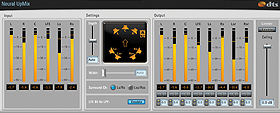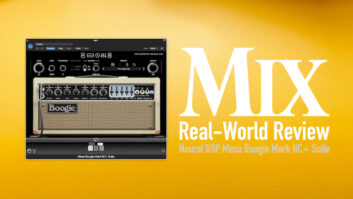
Neural UpMix by DTS allows you to create real-sounding surround environments via a simple GUI.
Neural UpMix by DTS is a software version of Neural’s intelligent upmixing hardware processor. It can be used as a real-time plug-in with surround-ready software like Pro Tools HD, Pro Tools LE with Avid’s Complete Production Toolkit or Nuendo, but it can also function as an Audio Suite plug-in in Pro Tools. Rather than serve as a matrix decoder—which would extract surround information from 2-channel program information specifically designed to be decoded—the goal of this tool is to take any 2-channel audio and create a truly enveloping surround sound version. In recognition of the growing community of 7.1 listeners wanting to enjoy the maximum benefits of the Blu-ray format, the plug-in will upmix 2.0 material to 5.1 or 7.1, or even 5.1 to 7.1.
EASY TO GET AROUND
The GUI is attractive and self-explanatory, and its Width and Depth controls execute the bulk of decision-making. The Depth control determines the front-to-back weight of the audio that is output, while the Width control dictates how much center-weighted signal will feed the actual center channel, vs. the left- and right-front speakers or phantom center. A graphic depiction of the playback environment helps illustrate which of two 7.1 upmix variations is selected. One setting adds the sixth and seventh channels, each 90 degrees off-center, in accordance with recommendations from the 7.1 home theater specs from ITU and THX. The other adds the additional channels to the rear of the playback position, just outside the traditional surrounds. Large peak/VU input meters—and dedicated peak/VU meters for the outputs created by the processor—simplify signal management. Each output has a post-process trim control, and there’s a master output control with an optional limiter.
UPPING THE MIX
My first use of the software was to attempt a 5.1 upmix of symphonic music that had been recorded with a Decca Tree and subsequently mixed to 2-channel stereo. I adjusted the Depth control with an emphasis on maintaining the sense that the orchestra was in the front of the listening position and the sound was interacting with the concert hall’s acoustics. The results did not necessarily align with those expectations. Contrary to what I had envisioned, the process did not extract exclusively ambience and draw it into the rears; instead, the entire sound of the orchestra now enveloped the listening position. Though not my original intention, the sound was striking. The sonic experience produced here quite apparently differed from the simple end result of adjusting a front-to-rear panning control or a divergence panning control included in a DAW (using Pro Tools HD as my reference). Looking to prove—in a scientific way—that truly unique information was being generated for the surrounds, I summed the left-front channel with the left-surround channel, flipping the left-front out of polarity relative to the rear channel. Complete cancellation did not take place, thus proving that unique, yet still perfectly complementary information was being generated.
My curiosity led to further testing. Soloing each of the individual playback channels revealed rich-sounding audio. Each channel exhibited a full broadband frequency response without audio artifacts. When moving my head around the soundfield with all channels playing back, there were no washy, phased sounds. Next, I wanted to see how this sound would hold up to matrixing and downmixing. I tried processing upmixed signals from DTS Neural Surround UpMix with the classic Dolby SEU4 and decoding with the SDU4. I then tried a more modern Neyrinck ProLogic II encoder, decoding with a Denon Professional receiver. In each case, the surround image maintained integrity, with the ProLogic II mix sounding very close to the original. The encoded Lt/Rt through two speakers also sounded very clean, again with no distracting phase discrepancies. When doing a true stereo downmix, using the onboard facilities of a Martinsound MultiMAX, I dropped the center 3 dB before splitting it off to the left and right, and also attenuated each surround channel by 3 dB before combining them with their respective channels. The end result was also remarkably clean.
VIRTUALLY REAL
After these tests, I returned to creating a virtual concert hall around the 2-channel classical piece. At this point, I thought a reverb processor might do the trick, so I used the Waves Renaissance reverb on a Large Hall–type setting. I ran the 100-percent wet reverb track through Neural UpMix and adjusted the depth to place the weight of the generated ambience slanted toward the rears, which resulted in a very convincing virtual sonic environment. Normally I would rely on a TC Electronic System 6000 generic reverb to perform this kind of process, for lack of any kind of alternative with acceptable sound quality. Having said that, I would not turn my nose up to Neural UpMix as a very acceptable alternative for creating simple virtual environments. Given the reasonable price of Neural UpMix relative to the System 6000, this could be a great way for smaller studios to unlock surround potential from their collection of stereo plug-ins.
This plug-in particularly shined when dealing with ambient sound effects for film. I processed a variety of source material, including stereo recordings of rain, ocean sounds, birds and other noises that create the environment in which a scene is supposed to play out. In each of these cases, I again experienced rich, full-frequency sound that was free of noticeable artifacts or phase issues. Downmixing, folding down and matrix decoding all worked with no undesirable effects. I imagine this application was one of the plug-in’s primary intents, and it works exactly as it is supposed to.
CAN I LIVE WITHOUT IT?
As far as sound quality goes, I’d give this plug-in a perfect score. It does what it aims to do and without sonic tradeoffs. The GUI is well thought out and easy to use: Simply insert the plug-in on a stereo track, and it automatically turns into a surround track. When it comes to features, there aren’t many bells and whistles. Mono audio cannot be upmixed to stereo, nor to surround.
Also, some competing products offer a rotation control, which lets you rotate sound relative to the mix position, allowing a change in the distribution of energy. Neural UpMix shifts the balance from front to rear, but the image is always balanced across the center axis of the room. What if the sound is meant to radiate from the left-surround and grow to wrap around the listening position? Being able to rotate the entire surround image would be useful in this case. DTS explains that the lack of ability to rotate the surround image was a deliberate decision to prevent phase issues when audio is downmixed in a consumer environment. This wish aside, if you are adding stereo material into a 5.1 or 7.1 mix, or trying to upmix M&E’s for surround use, this plug-in is indispensable.
Brandon Hickey records and mixes audio for independent films and teaches audio post.

Click on the Product Summary box above to view the Neural UpMix product page.







